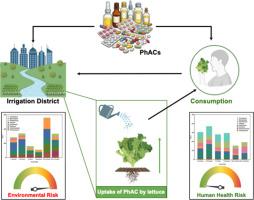哥伦比亚灌溉用水和生菜作物中药物的发生及风险评估
IF 7.7
Q2 ENGINEERING, ENVIRONMENTAL
引用次数: 0
摘要
本研究首次详细调查了哥伦比亚Cundinamarca的Sabana de bogot本文章由计算机程序翻译,如有差异,请以英文原文为准。

Occurrence and risk assessment of pharmaceuticals in irrigation water and lettuce crops in Colombia
This study presents the first detailed investigation into the occurrence and risk of pharmaceutically active compounds in irrigation water and lettuce crops within the critical agricultural region of Sabana de Bogotá, Cundinamarca, Colombia. Systematically were analyzed eight pharmaceutically active compounds (PhACs)—including an antiepileptic drug, five antibiotics, one antihypertensive, and one anti-inflammatory—across six farms along the Bogotá River using liquid chromatography-tandem mass spectrometry.
The findings reveal a widespread presence of PhACs in irrigation water, with Farm C-Principal exhibiting the highest detection frequency (97 %) and M-La Victoria showing the highest total concentration (613 ng/L). Clarithromycin and ciprofloxacin were the most concentrated among consistently detected PhACs.
Principal Component Analysis was used to reduce the dataset's dimensionality and identify correlations among the variables. The study also estimated PhACs loading rates into lettuce crops using average water concentrations and CropWat software, with estimated inputs ranging from 5.2 to 26.3 g/ha per crop cycle. Crucially, several PhACs were detected in lettuce, with diclofenac (up to 70.9 ng/g) and trimethoprim (up to 61.6 ng/g) being the most frequently observed. While ecological risk assessment indicated a high risk from pharmaceuticals in irrigation water, particularly clarithromycin, trimethoprim, and diclofenac, the human health risk from consuming the irrigated lettuce appeared negligible. This research provides critical baseline data on PhACs contamination in the Sabana de Bogotá region, which is essential for informing future research and developing effective mitigation strategies.
求助全文
通过发布文献求助,成功后即可免费获取论文全文。
去求助
来源期刊

Journal of hazardous materials advances
Environmental Engineering
CiteScore
4.80
自引率
0.00%
发文量
0
审稿时长
50 days
 求助内容:
求助内容: 应助结果提醒方式:
应助结果提醒方式:


